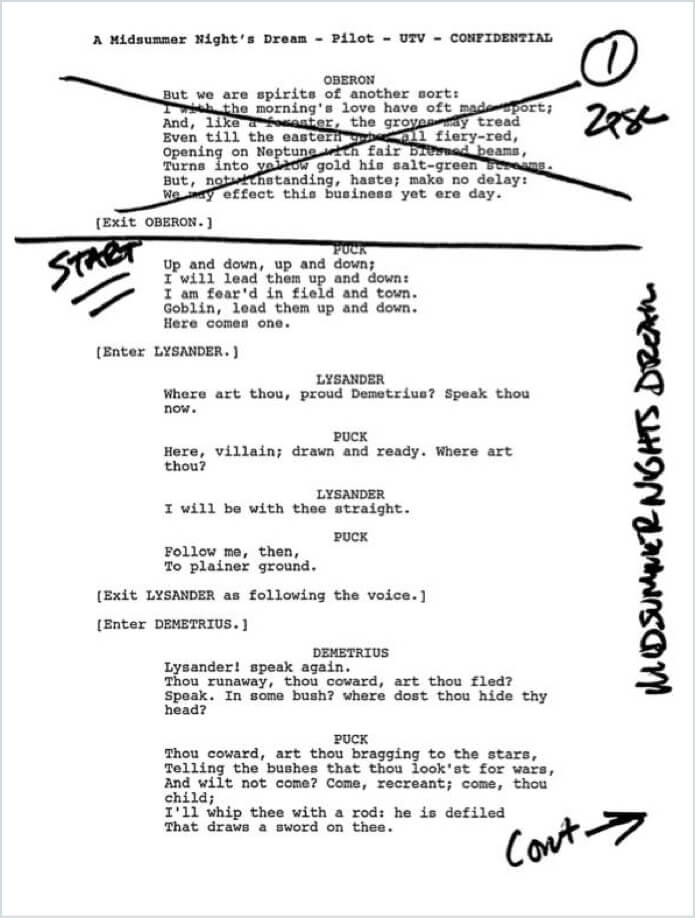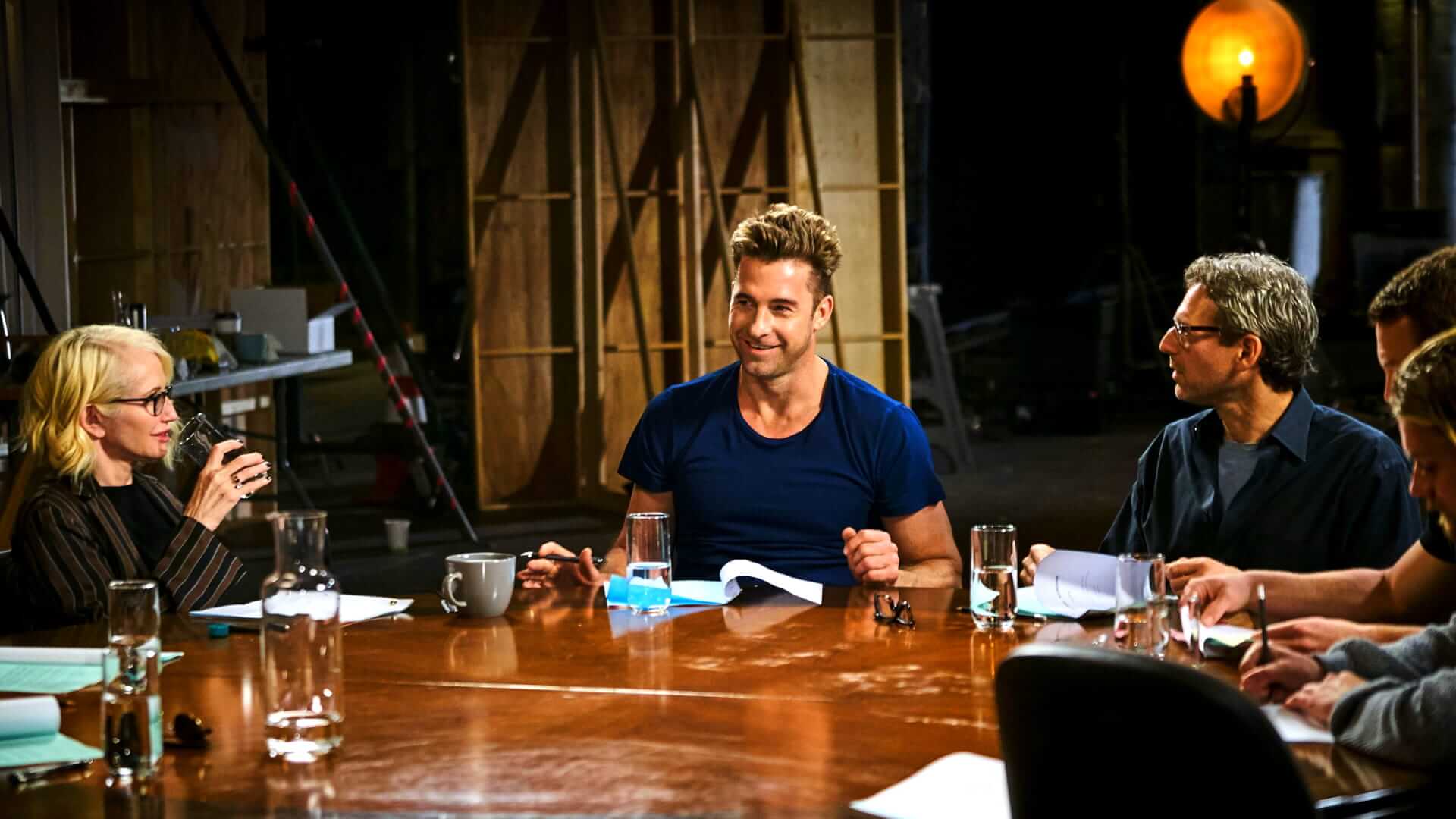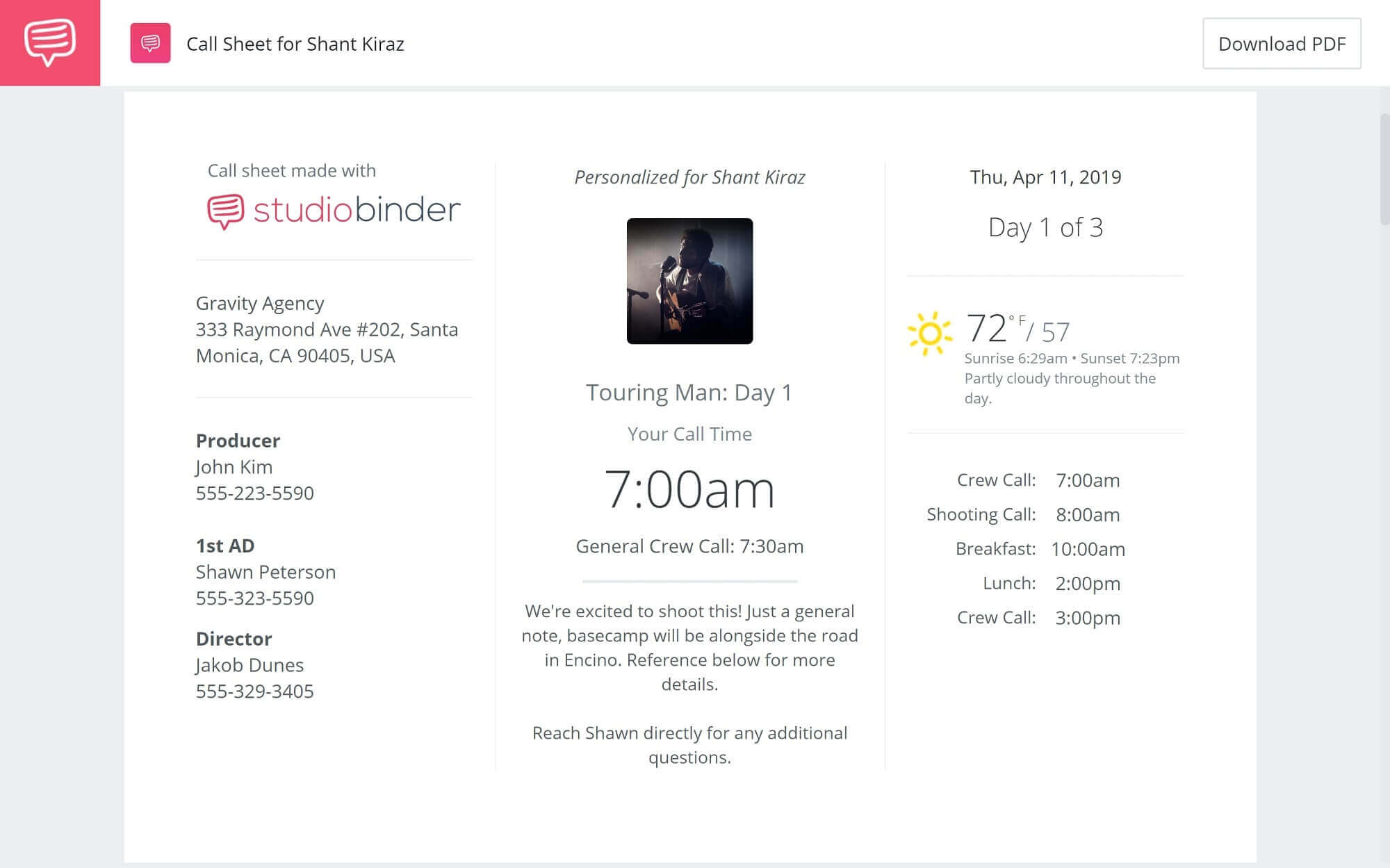When your pre-production work heads for production, your project’s table read is often the first in-person meeting for key players. Even though it’s an exciting time, it’s crucial for you to take a breath, prepare, and make the most of every opportunity your table read presents.
In this post, we cover logistics and creative concerns you’ll need to address in your read-through. We also give you pro tips so you can encourage your team, hone the story you’re telling, and take full advantage of the table read. With everyone likely hearing the entire project performed aloud for the first time, it’s a make-or-break moment for your success as a filmmaker. Read on for the tools to get it right.
TABLE READ
Why do you need a table read?
You and your team have been diligent about development and the Pre-Production process. You’ve been focusing on every step you need to tackle to move into production. The script is ready, casting and auditions are complete, all the pieces are falling into place — or rather, they’re getting beautifully arranged in place thanks to your dedication.
Now is not the time to slip. Let’s make sure your project’s execution delivers on the story in your head and on the page. The only way to do it? A read-through of the script, with the whole team on board.
With a table read, you’ll spot any glaring weaknesses — and determine how to fix them — before cameras roll. You’ll strengthen what’s working, and fix what isn’t. So, exactly what is a table read? Quick definition time:
TABLE READ DEFINITION
What is a table read?
A table read is an organized reading of a script or screenplay in film, television, and theater. Also known as a read-through or table work, table reads are usually scheduled and performed at the beginning of the production phase in film and TV, and at the start of rehearsals for live theatrical performances. The table read is one of the first chances for financial and creative team members to come together.
What does a table read achieve?
- Brings together the creative, financial, and production personnel.
- Allows for a critique of the script.
- Confirms casting decisions.
In film, the principal cast attends the table read along with financiers, executives, and department heads such as the director of photography, production designer, and costume designer.
Usually, the director or a member of the production team will read action lines and dialogue for “bit” parts.
In television, the entire cast, sit around a large table, and introduce themselves, along with the character they’ll be playing. In theater, actors are expected to grow into their characters over the course of the table read. Everyone might also hear original music for the first time.
Often, a read-through incorporates elements from all three mediums.
What is a table read like with almost unlimited resources? Check out this table read for Beauty and the Beast to get an idea of what a large-scale read-through can accomplish:
A big-budget movie table read for Beauty and the Beast
This example sets the bar pretty high. You can keep it loose or run a tight ship as you impart your own style into your project’s table read. Just make sure you go in with clear goals, and stay alert to achieve them.
And remember, the read-through exists to help you and everyone else.
ACTING OUT THE SCRIPT
Choose your audience
When you approach your read-through, know what you want to accomplish. If you simply announce, “We’re doing a table read,” end of story, you’ll still get value out of it, but you likely won’t maximize everyone’s time.
So, figure out your goals. Do you want to impress your investors and maybe even secure more money? Is your objective to test out the material and cast, and workshop performances and story?
Your table read objectives determine your table read audience. Figure out what you want, and then invite people accordingly.
“We invite investors and put together our favorite actors to help sell the material. Sometimes the writers and the creative team need the screenplay read so that they can hear how it plays. They often invite other writers so that they can discuss it after and do a “punch-up” for dialogue or for comedy.”
— Marci Liroff, Casting Director
Do you need to send out formal invitations? An e-vite or Paperless Post? Probably not. A read-through is an industry-standard step in the production process, so it makes sense to use call sheets.
For efficiency, you’ll want to keep production contacts and build call sheets in a production management hub.
Call sheets in StudioBinder automatically link to maps, weather, and nearby hospital info. You can personalize call times based on crew members, and send, track, and confirm receipt of call sheets. You'll understand more on this with our ultimate guide to call sheets.
Here’s a sample call sheet. Follow the image link below to see how you can confirm receipt, check out who else is being called, and bring up maps and parking details:
Bring cast and crew to your table read with call sheets
You’re going to generate and send call sheets every day during production, so now is a perfect time to perfect your call sheet process.
A call sheet also reminds everyone that they’re here to work. Everyone’s here to have fun, be creative, push limits — and, yes, deliver the goods.
RELATED POSTS
READ THE FILM SCRIPT
Where to hold the table read
You’re getting shoot locations squared away, the production schedule is coming together, and all the important pieces are lining up. Almost there. One of the last steps before production is the table read. Everybody’s meeting in person to table read the screenplay.
One question: Where do you put them?
The space you use for your table read doesn’t have to be a fancy stage or set. It can even be a living room. If you want to set a professional tone for the project, however, a theater or working performance space would be a wise choice.
To find a location for your read-through, talk to members of your team. Ask your location scout. Call small theaters. Check out services like Peerspace or Wrapal to find spaces. You have options.
Wherever you hold your table read, make sure it’s well-ventilated and a stable temperature. With so many bodies packed into one space, air conditioning or heating might be a necessity.
Windows can be distracting for longer reads, so if you want to help keep focus, draw the blinds.
Thanks to glorious 21st century technology, a table read can also take place remotely. Whether you're working through a global pandemic, or you've got actors and department heads unavailable to physically participate, video conferencing is also an option.
Here's an example of a virtual table read, courtesy of the folks behind Community. Enjoy!
Community • Virtual Table Read
TABLE READ TIPS
Provide refreshments
Everybody wants to bring their A-game to a table read. Energy is high, people want to please, the whole room feels alive. It can be draining as the read-through progresses.
You don’t want to put time and effort into your table read only to watch everyone run out of steam. Water and snacks will keep your team pumped up. A standard craft services table will suffice.
Some filmmakers provide full meals at read-throughs. This can be a pro move, but make sure to schedule any meal break so it doesn’t distract or break the flow. When in doubt, keep refreshments simple and light. It is, after all, a table read, not a medieval banquet.
TABLE READ SCREENPLAY
Print hard copies of the script
While many people will have laptops or tablets at the ready, it’s always wise to bring enough copies of the script for everyone. This will also give people space for making notes.
Everyone will have an opinion on the script, the dialogue, and the characters, so encourage their feedback. Now, don’t forget the pens.
READ-THROUGH NECESSITIES
Bring other read-through materials
Bam. Here’s a script. It’s 120 pages long and we start our table read in 10 minutes. Be ready. That’s a pretty tall order, no? If you want to get the most out of your read-through, you’ll of course want to give everyone a full script.
But you’ll also need to provide team members with relevant tools to help them prepare. What exactly should you bring with you?
Cast List
You’ll need a cast list so you can easily recognize actors.
Character Breakdowns
Provides a quick overview of each character and their place in the story.
Script Notes
Script notes are a great way to make sure you and your talent are on the same page.
Script Sides
Excerpts of the script that you can read together. Now, about script sides.
They’re a process unto their own. But how do you create sides properly?
Just a few years ago, pulling sides for a script read-through was a real headache. A lot of productions still build script sides the “classic” way. This requires chopping up a PDF, using a pen to annotate names and production details, and crossing out unrelated chunks, like this:

Make character script sides for your table read
Modern productions tend to favor an all-in-one script side solution, which saves time and energy, and makes it easier to track who gets what, and when.
There are probably a million ways to be more productive than annotating, copying, and collating PDFs for hours on end. Check out the most efficient way to generate sides with StudioBinder:
Keep your script, contacts, and sides in one place
The goods you provide to your cast and crew at the read-through are all geared towards a shared goal: make the table read productive, because it will lead to a better production in the long run.
Think of your table read as a miniature version of your larger production, albeit one where you still have plenty of room to tweak, improve, and adjust before cameras really roll.
When you approach the read-through this way — with call sheets, provide snacks, bring everyone a script and pertinent supplemental materials — you’re sending a message that you and your project are to be taken seriously.
MOVIE TABLE READ
Invite department heads
Key department heads should attend the table read. Of course, who you want in the room depends on what kind of project you are making, but a few roles need to be there no matter what.
These include your director of photography, production designer, costume designer, and hair and makeup artist. All of these department heads will need to see and hear who and what they will be working with.
The read-through also stands as a great opportunity to obtain actor sizes and measurements, either on breaks or at the end of the table read.
Another reason to include members of the team? Hearing the actors’ interpret their characters up close, fresh and in-your-face, can be an inspiration. The artists and craftspeople who make up your team will get energized. They’ll want to rise to the project and give it their all.
If you’re doing a table read for a musical, you need to invite vocalists and the musical director. That means you’ll need music. So, grab your crew list and your call sheet. Double check to make sure everyone who needs to be at the read-through will be present.
RECORD THE READ-THROUGH
Make sure someone hits “record”
You should always discreetly record the table-read. Not in a “hidden camera” or practical joke sense. Just as unobtrusively as possible.
You’ll want to be able to go back and review the reading and everyone’s response to the material. You can also review the first impression performances. But these are not even the most important reasons to record your read-through.
Recording the table work is useful for all the extra materials you will need for marketing and distribution. Behind-the-scenes of production, from beginning to end, is a great way to get B-roll for your EPK or other marketing materials.
In the case of the TV series The Office, recording the final table read preserves the magic of the team and gives insight into the process:
Good thing they recorded this table read for The Office
As you saw in the video, a table read can function as a productive “work party.” Everyone is there to do a job, but it also can feel like a mixer, a wedding, a reunion, and a welcome party all rolled into one.
Some filmmakers even conduct short on-camera interviews of actors and crew. A few words, out of character, are very useful when time to sell your film.
TABLE READ DIRECTION
Communicate what you want
The first, some say only, solid instruction for actors at a table read is not to act. Why wouldn’t you want them to act? There are several reasons you wouldn’t want actors “performing” during a first read-through.
First, a great actor can make anything sound good, and you don’t want anything to sound good. If a line is a clunker, you’ll want it to land like a wet washcloth in the room, not like fireworks. If a passage is confusing, you’ll want to see confusion on everyone’s faces instead of awe at an actor’s commitment to the role.
Bottom line: A dynamic performance can mask deeper problems, and the table read is where you need to be able to spot them.
Another reason not to have them acting is they could be nervous or excited and won’t be turning in their best work. It shouldn't be like holding auditions all over again.
Lastly, actors are natural showfolk. The personalities you’ve hired could overshadow the script work, which doesn’t benefit anyone.
Have the actors read in a straightforward manner. By the end of most read-throughs, actors won’t be able to hide their raw interpretation of their characters. Embrace these “non-performances,” and build on them.
A director is a leader, and at this stage leadership means letting the process unfold. Be supportive and encouraging, let everyone know you’re there to bring out the best in every performance, but set expectations: it’s a table read, not opening night.
This is also a peek at the actors’ future work. You will know that you’ve gotten the right actors for the roles...or not.
DIRECTING A TABLE READ
Be an active listener
The whole point of the table read is to bring the written word to life. You do this by being an active listener.
Pay attention. Let people know you’re listening through nonverbal cues. Give feedback when appropriate, defer judgment, and keep any response focused on increasing team morale and synergy.
First, listen to your dialogue. Is it repetitive, clunky, too formal, or lackluster? How does it flow? You might need a refresher with tips on writing better dialogue.
Second, the action lines are not an afterthought. Listen to the way the lines interact. These words will mean an awful lot to the pacing of the finished film.
Third, watch your actors and listen to them during the read-through. Find what’s honest, and what’s artificial. You’ll not only learn a lot about their performances, but about the material they’re reading as well.
TABLE READ TALENT
Rethink talent
Since the table-read is one of the few pre-production meetings of the talent attached to the project, the director needs to assess the suitability of the actors. Directing actors can be easy, or it can be hard.
The director can also get a sense of chemistry. As in, does it exist?
Lastly, the director is able to see how the actors work and how they work with each other. This is important for the production because there is often very little rehearsal time on set.
As you can see in this read-through for Forgetting Sarah Marshall, the chemistry was firmly in place:Feeling the love at the table read
If you’re a director, you’ll want to take notes.
Details you might want to consider include voice and diction, emotional displays (or lack thereof), the pace of the action and even things like body language and mannerisms.
RELATED POSTS
READ-THROUGH Q&A
Enjoy a little Q&A
Question and answer time almost goes without saying for a successful table-read. You want to hear everyone’s thoughts, good and bad.
By all means, take questions and try to give answers. The most important thing here is to have a list of questions ready for you to ask your actors.
The questions may include: Were your character’s motivations clear? Is your character arc clearly defined? Were you able to follow the plot? Is the protagonist and antagonist clearly defined?
The next most critical note at this point in the read-through is, “Don’t be defensive.” It’s a natural response to defend your work, but the talent and crew are offering their true and valid assessment of the script. Take it in.
Like anything, you can take the responses with a grain of salt. Only you can determine if the comments are helpful to your writing process. As a general rule, if multiple people give you the same note, you might want to pay close attention.
Congratulations. You’ve got what it takes to conduct a successful table read and move into production. Make the most of it, stay open and aware, and adjust what needs to be adjusted. Next comes production.
UP NEXT
Ultimate guide to call sheets
When you get through your table read, you know you'll soon be ready to start shooting. Of course, this means you’ll be sending out call sheets for every day of production. A well-made call sheet can be the difference between a successful shoot and a production nightmare. Check out our ultimate guide, and get a free professional call sheet template.

